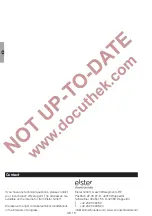
GB-9
D
GB
F
NL
I
E
▷
When heating up for the first time, for example,
vapours may be emitted from seals or coatings
which may cause unpleasant odours.
All valves of the installation must be checked for
tightness before ignition.
Coarse adjustment with the furnace cold
▷
Coarse adjustment of the air volumes, see
page 6 (Preparing commissioning).
Limit the maximum gas volume.
▷
Open the restrictor around halfway.
Open the gas supply.
4
Ignite the burner.
▷
The safety time of the automatic burner control
unit starts to elapse.
5
Check and adjust the gas and air pressures.
6
If no flame is formed, reset the automatic burner
control unit, purge the combustion chamber and
ignite the burner again.
▷
The burner ignites and proceeds to normal op-
eration.
▷
If no flame is formed after repeating steps
5
and
6
multiple times – see page 13 (Assistance in
7
Check the differential pressures ∆p
gas
and ∆p
air
and the negative flue gas pressure p
FG
, and set
them to their desired values.
▷
The gas, air and motive air settings affect each
other. We recommend reading these pressures
at the same time.
▷
Check the settings by conducting a flue gas
analysis (in the flue gas connector in the case of
an indirect heating system or in the furnace in the
case of a direct heating system). Ensure that the
furnace pressure is positive for a direct heating
system to avoid falsification of the measurements
by infiltrated air.
Tightness test
DANGER
To ensure that there is no danger resulting from a
leak, check the gas connections on the burner for
leaks immediately after the burner has been put
into operation.
8
Fine adjustment with a hot furnace
▷
Final adjustment of the burner should be carried
out at maximum furnace temperature and high
capacity demand.
9
Heat the furnace.
0
Watch the furnace pressure and O
2
value in the
furnace atmosphere. Avoid negative pressure
and substoichiometric operation of the burner. If
necessary, adjust the settings of the combustion
air and motive air.
Check the differential pressures ∆p
gas
and ∆p
air
and the negative flue gas pressure p
FG
at max.
furnace temperature, and adjust them using the
appropriate restrictor.
∆
p
0
p
2
p
1
▷
Check the settings by conducting a flue gas
analysis (in the flue gas connector or eductor in
the case of an indirect heating system or in the
furnace in the case of a direct heating system).
Ensure that the furnace pressure is positive for
a direct heating system to avoid falsification of
the measurements by infiltrated air.
DANGER
Risk of explosion and poisoning in case of
burner adjustment with an air deficiency!
Ad-
just the gas and air supply so that the burner is
always operated with excess air – otherwise CO
will form in the furnace chamber. CO is odourless
and poisonous! Conduct a flue gas analysis.
Watch the furnace pressure at high capacity
demand and various furnace temperatures to
optimize the motive air setting.
▷
The furnace pressure should be slightly posi-
tive in all operating states (0.1 to 0.3 mbar).
If the positive pressure exceeds approx.
0.3 mbar, increase the flue gas extraction
rate to prevent the burner being damaged.
If there is a negative pressure in the furnace
chamber, reduce the flue gas extraction rate to
avoid infiltrated air.
Blocking and recording the settings
Produce a measurement report.
4
Remove the measuring devices and close off
the test nipples – tighten the grub screws.
5
Block and seal the adjusting elements.
6
Induce a flame failure, e.g. by pulling the plug off
the ionization electrode. The flame detector must
close the gas safety valve and signal a fault.
7
Switch the system on and off several times while
monitoring the automatic burner control unit.
8
Produce an acceptance report.
DANGER
An incorrect change of the burner settings may
change the gas/air ratio and lead to unsafe oper-
ating conditions. Risk of explosion in case of CO
being formed in the furnace chamber! CO is odour-
less and poisonous!
Summary of Contents for ECOMAX Series
Page 17: ...GB 17 D GB...

































